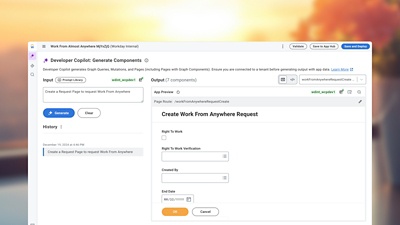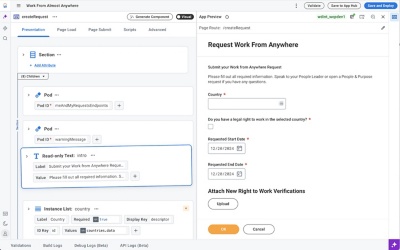App Development
Unleash the power to build.
Workday Extend lets you take your ideas from alpha to beta to done—with low- and no-code developer tools. Move forever forward by creating apps and solutions for your people, finance, and IT needs.

WHAT YOU CAN DO
Build HR and finance apps. In a snap.
Using the same technology that powers our platform, you can harness your people and money data to build unique, intelligent, and interoperable apps—amplifying your investment in Workday.
-
No- and low-code tooling
-
Consistent UI
-
Single security model
-
Extensible object model
-
Process orchestration
-
AI capabilities with Workday Illuminate™
-
App lifecycle and monitoring

Workday Illuminate
Next-level AI.
Next-level productivity.
Workday Extend Professional provides responsible AI services through Illuminate and our trusted technology partners.
Enter the Workday AI Gateway.
Build quickly and confidently with APIs that enable skills and sentiment analysis, document intelligence, translations, HR questions, anomaly detection, and more.
Supercharge productivity with Gen AI.
Build faster with Workday Extend Developer Copilot, our conversational AI companion that generates code with context—taking skills and productivity to a new level.
Harness the power of AWS.
Expand the impact of your Workday Extend apps by leveraging trusted AWS AI services such as text analysis, text extraction, translation services, and more.
Full-on innovation. Full steam ahead.

Retire legacy systems and consolidate applications by extending Workday to meet your unique needs.
Increase productivity across Workday and other systems, eliminating duplicate or error-prone manual processes.
Empower employees with new capabilities that leverage the Workday look and feel, increasing productivity and engagement.
Create apps powered by Illuminate that improve operations and streamline decision-making.
Collaborate and create new apps through an intuitive, browser-based experience that offers visual and preview modes.

“With Workday Extend, our developers can build and maintain our own apps in HR, enabling us to support important business needs quickly. And now with Workday AI and ML services, we will further grow our toolbox of capabilities to build new apps faster and with less risk because they’re on the Workday platform.”
Accelerate app development.
Extend the data object model.
Rapidly generate new data objects and business processes in Workday, protected with the same security you already trust.
Orchestrate processes everywhere.
Our drag-and-drop tool defines logic, maps, and loops with data, and performs transformations so you’re fully optimized.
Innovate on a trusted platform.
We apply the same audit and security controls to what you build, keeping your data secure and accurate while maintaining governance.
Reduce ongoing maintenance.
The UI, data, logic, and security of your apps remain update-safe from one Workday release to another—no recoding or refactoring needed.
Deploy apps on a global scale.
Seamlessly deploy your Workday Extend apps across your global workforce and proactively monitor performance.

Workday Developers
Join the brightest builder community around.
We have 2000+ apps in production from 1000+ customers and 30 certified partners, fueling our growing ecosystem. Workday Extend opens the door to a booming marketplace of packaged solutions and app templates as well as our active Workday Developer forum.
Workday Extend Packages
Meet your unique needs.
Whether you’re new to the game or a seasoned builder, we have a plan for you.
Workday Extend Essentials
Includes
-
Fixed Annual Price
-
App Builder
-
Up to 3 Apps in Production
-
1 Developer Tenant
-
10M Data Model Instances
Workday Extend Professional
Includes
-
Fixed Annual Price
-
App Builder
-
Up to 10 Apps in Production
-
3 Developer Tenants
-
100M Data Model Instances
-
Workday Extend Developer Copilot
-
Workday AI Gateway
-
Native AWS Integration

